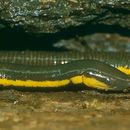Caecilians (Order Gymnophona)
(
англиски
)
добавил EOL authors
Caecilians (Order Gymnophiona) and their closest fossil relatives are amphibians that are grouped as the clade Apoda. The name caecilian derives from the Latin 'caecus', meaning "blind", due to the small or sometimes nonexistent eyes. Carolus Linnaeus named the first species he described as Caecilia tentaculata (2).Gymnophona derives from the Greek for 'naked snake', as caecilians were thought to be related to snakes.
Caecilians lack limbs; smaller species superficially resemble worms, while larger species resemble snakes. The tail is short or absent and the cloaca is near the end of the body. The skin is smooth and contains calcite scales, which are probably a secondary development, rather than suggesting that caecilians are related to the fossil Stegocephalia (2). The skin has many ring-shaped folds (annuli), partially encircling the body, giving a segmented appearance. It has glands that secrete a toxin to deter predators (1).
Caecilians' vision is limited to dark-light perception (4) and their anatomy is highly adapted for burrowing. They have a strong skull and use their pointed snouts to force their way through soil or mud (2). In most species, the bones in the skull are reduced in number and fused together, while the mouth is recessed under the head. The muscles are adapted to pushing their way through the ground, with the skeleton and deep muscles acting as a piston inside the skin and outer muscles. This lets the animal anchor its hind end in position, forcing the head forwards and pulling the rest of the body up to reach it in waves. In water or very loose mud, caecilians swim like eels (1). Aquatic caecilians in the family Typhlonectidae have a fleshy fin running along the rear section of their bodies to enhance propulsion in water (5).
All but the most primitive caecilians have two sets of muscles to close the jaw; other creatures have one pair. These are more highly developed in the most efficient burrowing caecilians and seem to help keep the skull and jaw rigid (1).
Adapting to an underground life, the eyes are small and covered by skin for protection, but caecilians are not blind. Their sight is limited to simple dark-light perception. All caecilians have a pair of tentacles, located between the eyes and nostrils. These are probably used for a second olfactory capability, in addition to the normal sense of smell based in the nose (1)
Except for two lungless species (Atretochoana eiselti and Caecilita iwokramae) all caecilians have lungs, but also use their skin or mouths for oxygen absorption. Often, the left lung is much smaller than the right one, an adaptation to body shape also found in snakes.
Caecilians mostly live hidden in the ground, but some live in water. They are found in wet, tropical regions of Southeast Asia, India, Bangladesh, and Sri Lanka, parts of East and West Africa, the Seychelles, Central America, and in northern and eastern South America. In Southeast Asia, they occur as far east as Java, Borneo and the southern Philippines, but have not crossed Wallace's line and do not occur in Australia or nearby islands.
Mature caecilians seem to feed mostly on insects and other invertebrates. Captives will eat earthworms.
Caecilians use internal insemination. Males insert a penis-like organ, the phallodeum, into the female's cloaca for two to three hours. About 25% of lay eggs, which are guarded by the female. In some species, the young are already metamorphosed when they hatch; others hatch as larvae, which are not fully aquatic, but spend the daytime in the soil near the water (1). About 75% of caecilians give birth to already-developed offspring. The fetus is fed inside the female with cells lining the oviduct, which they eat with special scraping teeth.
Wilkinson et al. (8) divided the Gymnophiona into nearly 200 species and 9 families (8). A tenth family, Chikilidae, has since been discovered (9). The classification is based on morphological and molecular evidence (8,9,11,12):
Rhinatrematidae - 2 genera, 11 species; South America
Ichthyophiidae - 3 genera, 50 species; South and Southeast Asia
Scolecomorphidae - 2 genera, 6 species; Africa
Herpelidae - 2 genera, 9 species; Africa
Chikilidae - 1 genus, 3 species; India
Caeciliidae - 2 genera, 42 species; South and Central America
Typhlonectidae - 5 genera, 13 species; South America
Indotyphlidae - 7 genera, 21 species; Seychelles, India, Africa
Siphonopidae - 7 genera, 19 species; South America
Dermophiidae - 4 genera, 13 species; Africa, Central and South America
The currently accepted phylogeny is based on molecular evidence examined by Wilkinson et al. (8) San Mauro et al. (12) and with the addition of Chiklidae as its relations were determined by its describers (9)
Caecilians left a sparse fossil record. The putative earliest fossil, Eocaecilia, from the Jurassic, had small limbs and well-developed eyes (3). Anderson and co-authors (6) suggested that caecilians arose from the Lepospondyl group of ancestral tetrapods and may be more closely related to amniotes than to frogs and salamanders, which arose from Temnospondyl ancestors. Many groups of lepospondyls evolved reduced limbs, elongated bodies and burrowing behaviors. Morphological studies on Permian and Carboniferous lepospondyls have placed Eocaecilia among these groups (7). Divergent origins of caecilians and other extant amphibians may help explain the discrepancy between fossil dates for the origins of modern amphibia, which suggest Permian origins and earlier dates, in the Carboniferous, predicted by some molecular clock studies of DNA sequences. Most morphological and molecular studies of extant amphibians support monophyly for caecilians, frogs and salamanders and a molecular study based on multi-locus data suggest a Late Carboniferous–Early Permian origin of extant amphibians (10).

